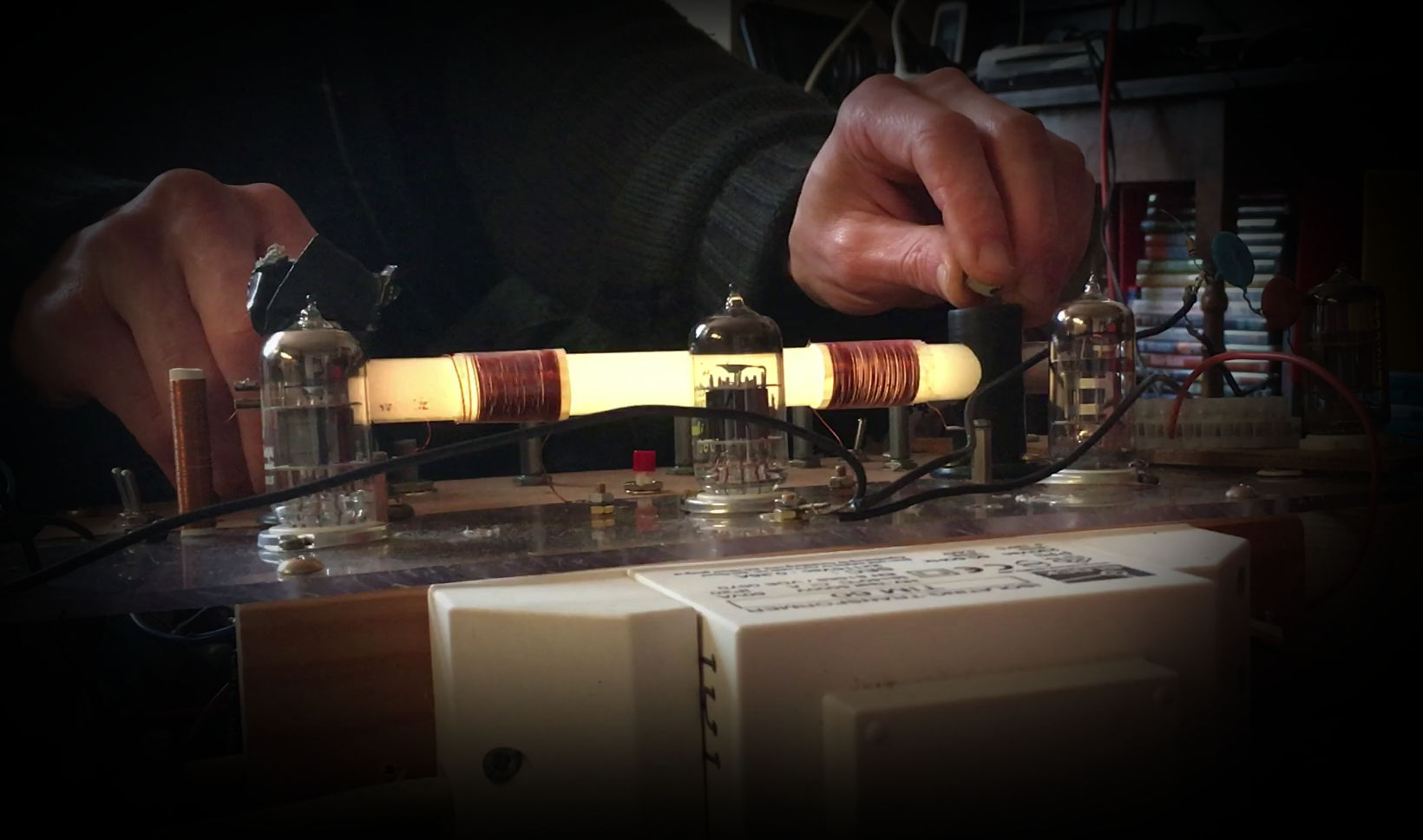
Telmatron
This project started with the idea for a plasma-based audio component, that could allow sound to be manipulated by magnetic fields. This was found to work particularly well for signals generated within a plasma, and a machine was developed to create and control suitable conditions, that we called a telmatron.
This page is a bit of a project scrapbook, with technical details, demos of the 'TM01' prototype in development, and other background stuff.
Technical details
Electrical signals are easily produced by fluctuations that occur naturally as electric current passes through a plasma.
Making audio with plasma is not new in itself, but our machine controls the stability of current (and so the sound) by varying the voltage/current and excitation of the plasma - producing a wide range of sounds at different conditions.
Increasing tube voltage/current generally raises pitch, which can also be subject to sudden changes if the plasma alters state. Increasing plasma excitation generally causes a progressive filtering and distortion of the signal, until the plasma stabilises and sound disappears.
Magnetic fields cause electron paths to curve, which tends to extend their lifetime in the plasma and so increase the local efficiency of the discharge. This means a hand-held magnet can have a significant influence upon the sound, varying with proximity and location along the tube.
Modulation of current and excitation affect the operating point of the instrument and can cause a surprisingly vocal output - experiments so far with T5 fluorescents have sounded a bit like a zoo - distorted howls and growls, shrieks, squeaks and whistles, as well as making sounds like brass, string or woodwind instruments, speech and birdcalls.
We hadn't expected the range of sound produced by different fluorescent tubes; some can operate in modes producing bass frequencies, whilst others mainly shriek or whistle across the operating range.
We do not expect to gain a precise understanding of how the plasma behaviour creates every particular audio noise - plasmas are subject to many different waves and instabilities (though most occurring at frequencies far above audible), and have complex dependences upon physical environment. The acoustic frequencies and voltage dependence we observe are characteristic of 'relaxation' oscillations, in which a DC discharge ignites and extinguishes rapidly - this mechanism will be a principal cause of the audio signal, and the effect of excitation likely to be maintaining the discharge to a some extent during the extinction part of the cycle. Acoustic waves occur commonly in plasmas and might also contribute, along with diverse damping effects by different plasma properties. Whatever the mechanism of production/propagation, these fluctuations will be influenced by interactions as current crosses boundaries within the plasma such as sheath regions around electrodes, and electrode form/material is likely responsible for much of the observed variation between tubes.
Project direction
In the short term Telmatronics are developing a simple telmatron-based synthesiser, that can be used with commercial fluorescent tubes to experiment with a new technology for noise-making. These tubes are being phased out in the next year or so (great timing!) but we are securing adequate supplies for now, and are starting to develop purpose-built tubes for the longer term.
Prototypes and demos
The short film below shows our first dual-modulated prototype:
And this video demonstrates some various sounds and basics of how they are controlled:
Different fluorescent tubes can produce quite different sounds. This video has clips of six types of tube making a range of noises:
Clips below show experiments sending control signals to the prototype from other instruments.
This video shows what happened when we plugged in a CV signal from an Arturia sequencer to a modulatuion channel of the TM01. The keyboard is also sending a timing signal to a Korg Monotribe.
Another experiment, using the gate signal from the KeyStep to send a step waveform... making some crazy noises!
Trivia
Why telmatron?
Telmatron means something like 'swamp tube' - this was chosen to describe the effect of the plasma excitation control, which does progressively swamp the audio signal, and also seems appropriate given the wet noises some tubes produce.
What about the earlier instruments?
The telmatron is not the first instrument to generate sound using a gas discharge - various early electronic instruments/electrophones such as the Trautonium also relied upon current fluctuations in small neon tubes and thyratrons. The non-linearities of gas discharges are problematic for maintaining a consistently reproducible pitch, and various schemes were devised to keep the plasma oscillations phase-locked with a reference signal. They were not widely used beyond the mid-20th century.
Links
These sites have been interesting and/or helpful for this project. Much information about plasmas and synthesisers is online, wikipedia is brilliant.
Fascinating history of electronic instruments
https://120years.net/wordpress/
Great collection of unusual instruments and resources
http://www.oddmusic.com/
Anarchic site featuring some crazy synthesisers
http://www.deviantsynth.com/
Fantastic resource for valve circuit design
http://www.valvewizard.co.uk/
Another great site for valve electronics
https://www.angelfire.com/electronic/funwithtubes/
GBVP - a project to restart valve manufacture in the UK
https://brimaruk.com/menugbvp/great-british-valve-project-2/
